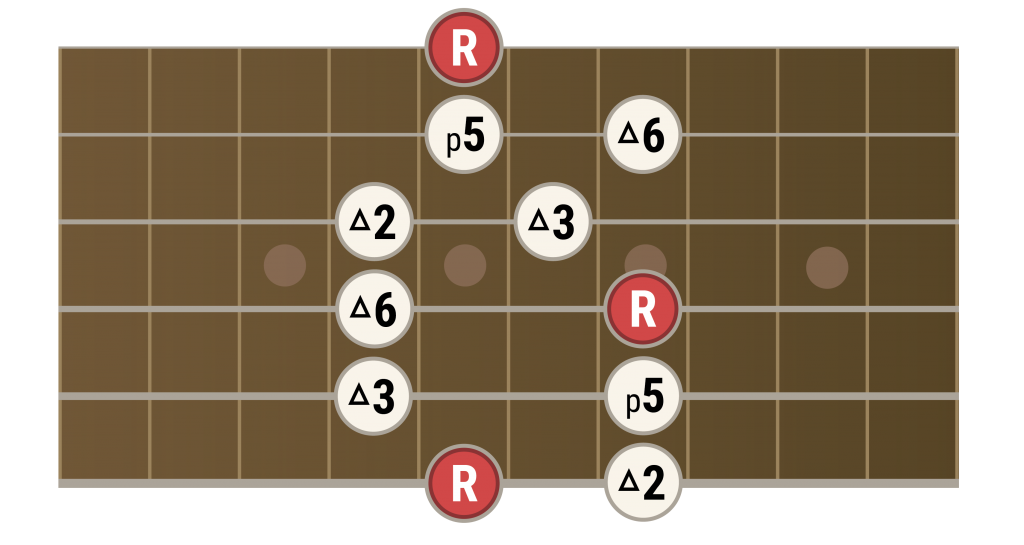One of the most useful applications of practical music theory is the concept of Intervals. Being able to both hear the Intervals and see them on the fretboard provides the means of breaking away from scale shapes, boxes and repetitive fretboard patterns. Intervals are everywhere, and we can use them to form scales and chords. In other words, Intervals can be viewed as fundamental building blocks of music theory.
Simply put, an Interval is the difference between two notes, but that doesn’t really explain the benefit of using Intervals. The real key to learning and using Intervals is that each Interval is referenced from the root note (the 1). The distance between the root and any of these Intervals will never change. For example, a Major Third will always be two whole steps (4 frets) up from the root, and so on.
As you are playing scales over different chords, you should be relating the notes you play to the Intervals for the chord you are playing over. That’s where the power of Intervals come in, because you will then be able to easier focus on the chord tones of the chord. That doesn’t mean the non-chord tone Intervals aren’t important. They sure are! Each Interval has its own sound, in relation to the root note. If you practice this concept regularly, you will over time develop the ability to instantly hear Intervals in melodies and in chords, and so on. In turn, that will enable you to truly “play what you hear.” It will take a lot of practice, of course, but it is very possible indeed.
In this article, I will describe the use of Intervals in the Major Pentatonic Scale. That means that we are not dealing with more than 5 notes/Intervals in our discussion. However, I need to point out that we have 12 notes in total to work with on the fretboard, and each of those can also be viewed as an Interval. I will not cover those “extra” Intervals in this article, but you can read more about this on Wikipedia, if you so desire.
Intervals & The Major Pentatonic Scale
The pentatonic scale has five notes, and we can use Intervals to dissect it.
The Major Pentatonic
The Major Pentatonic scale has the following Intervals:
- Root (1)
- Major Second (2)
- Major Third (3)
- Perfect Fifth (5)
- Major Sixth (6)
If we pick out the 1, 3, 5 above, we get a Major Triad. If you are playing a solo over a song in A Major, any of these 3 notes are chord tones for that chord. Any lick or line you play will usually sound best if you end on one of those notes. This is one benefit of knowing where the Intervals are on the fretboard, because you won’t have to worry about ending on a bad note!
Ex 1

2 Licks Explained with Intervals
Now let’s learn 2 simple blues licks, using the approach of understanding them from the “Interval perspective.” These licks start and end with the notes from a Triad (1-3-5 from the scale).
This lick is an A Major Triad lick, using the Major Pentatonic. It starts out by using the first 3 notes from the Major Triad. Then we go up to the 6th, which adds a nice flavor in blues. That note is used mostly as a passing note, because we are hanging on the root note next, before we travel back to where we started, playing a simple melodic line in the process. The last 3 notes are the notes from the Triad in reverse (Intervals 5, 3, 1).
Ex 2
Here we are combining Major and Minor, and the lick is made a bit more interesting by the use of triplets. The first 4 notes are the A Major Triad. After that comes a bend, and you can either use a whole-step bend from B to C# (2nd to 3rd) for that Major sound, or you can do a half-step bend, to get the Minor Third (C) sound it’s just a matter of taste. The remaining notes of this lick have the Minor sound. The last 5 notes are from the Minor Triad. In blues, it’s a cool thing to sometimes mix Major and Minor, and this lick is an example of just that.
Summary
We have now learned what Intervals are. We also learned how they can make up Triads, and the benefits of utilizing them in your solos. Finally, I’ve provided examples of how you can analyze and understand licks from this perspective of Intervals. I hope you find this article useful, and please don’t hesitate to contact me if you have any questions.


